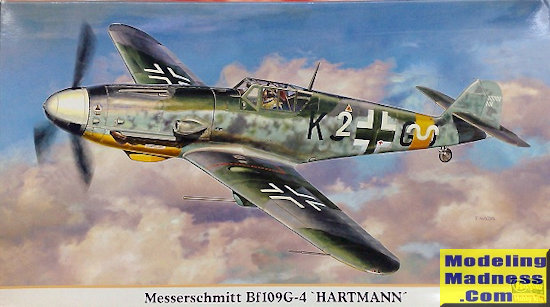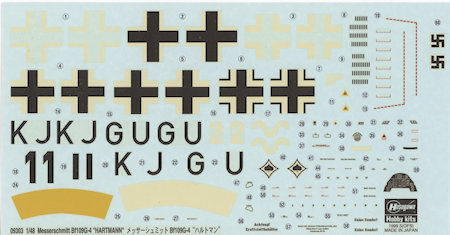
|
KIT # |
09303 |
|
PRICE: |
$10.00 from a vendor |
|
DECALS: |
2 aircraft |
|
REVIEWER: |
|
|
NOTES: |
1999 Special Edition |

|
HISTORY |
Rather than concentrate on the history of the 109 (which many readers probably have memorized by now), I'll just say a few words about 1/48 Bf-109G kits. Hard though it is to believe, there were decades when modelers had NO 1/48 109G !!
It is true. We had several 109Es (Aurora and Monogram), and later an F (Airfix), but the G models and later were sadly missing from the shelves. 1/72 didn't have it too bad as there was a selection of various 109s and the full family of them when Heller came on board with its group in the 1970s.
However, 1/48 modelers had to suffer in silence until Otaki produced a 109G-6 sometime in the early 1970s. It was a pretty good representation of the 109G and modelers were happy to at least have something. As often is the case with these early models, it had some shape problems. About the same time, Fujimi produced a 'multi-purpose' 109 kit that was allegedly able to do all the versions from G-2 to K-4. Well, sort of.
In reality, it also cut corners as there is no way to really do multiple versions in a single kit. As we know now, if nothing else, there needs to be a new cowl for the later versions. However, it did offer a tall wooden tail as an option as well as a bunch of spare bits. We were happy.
Around 1978 or so, Revell AG released their 109G-10. This was the first really accurate 109 yet done and a later version as well. It is not a bad kit at all, and one that holds up well even today. It must do well for R-M as it has been pretty well available under one name or another since it came out. Even better, it could be built as an honest, to goodness K model with a bit of scratch building and Revell even did a special K boxing at one time. Basically that meant outer gear doors and a taller tail. We didn't worry about such things as the different rudders and such as anal had not yet reached the heights that it has today!
Moving ahead to the mid/late 1980s. Fujimi comes on line with a series of very accurate 109s. Finally we could do all sorts of different variants right from the box. The major versions done were the G-6, G-14, G-14/AS, G-10 and K-4. No need to scratch build parts and an oodle of spares with each kit. Problem was that it was imported by MRC, who has always tacked on a very high surcharge to anything it imports, so these kits were at least $30 and eventually rose to $40 each. Many of them languished on the shelves unsold as modelers of the time couldn't justify that kind of price for a 1/48 109. Those of us who did buy them, did so when they were deeply discounted.
Just a few years after that, Hasegawa finally realized that Luftwaffe kits were a cash cow and has been milking it ever since. They have produced a staggering number of kits of the 109, starting with the F. Typical of the 'multi-use' nature of model kits nowadays, there are many common sprues for several of these kits. All the 109s have exactly the same wing, landing gear and interior sprues (C,D and F). From there, the other bits like wheels, fuselage, canopy, tail planes and such are added depending on the version being kitted. I'd be remiss to not mention the Hobbycraft kits. They are not quite up to the same standards, but then they are about half the cost. Hobbycraft does variants from G-2 to K and they look very good when done, though I'd rate them at just below Fujimi's efforts.
More recently are kits by ICM and Zvezda with the Zvezda kits being considered the most accurate, but are a real pain to build. The ICM ones are also a difficult build and so far both have not done G versions...yet. Eduard has released a 109G which was rather universally slammed due to scale issues and it has not seen the sort of releases that Eduard usually produces following one of their new kits.
If you check Tony Hodun's magnificent work on cataloguing the Hasegawa kits, you can see what has been done. Is Hasegawa finished with 109s? I seriously doubt it. These kits are excellent sellers and the company has realized that there is a market for the 109 in 1/32 as well.
|
THE KIT |
What this kit includes is a small resin sprue (not shown). This sprue has a
new upper cowling piece and the earlier spoked wheels used on the G-4 and
earlier 109s. The rest is the same and provides a nicely done interior with a
canopy section that can be posed open. Under the fuselage one can carry a fuel
tank, while under the wings, there is an option for the 20mm cannon. One will
need to pay attention and open holes for these prior to assembling the wings.
Both the markings options are shown with the cannon.
 This particular boxing of the G-4 kit is basically a decal change from the
standard G-6 model. All of the G-6 bits are included if you wish to model that
variant instead of the G-4 if you so wish to do that, though it would be a bit
of a shame. You have to scribe in the extra panel line on the F wings
and remove the outer sections from the circular wheel well on the lower wing to
square it off. A few fuel filler points also need filled in and the trim tabs on
the elevators need trimmed down.
This particular boxing of the G-4 kit is basically a decal change from the
standard G-6 model. All of the G-6 bits are included if you wish to model that
variant instead of the G-4 if you so wish to do that, though it would be a bit
of a shame. You have to scribe in the extra panel line on the F wings
and remove the outer sections from the circular wheel well on the lower wing to
square it off. A few fuel filler points also need filled in and the trim tabs on
the elevators need trimmed down.
 Decals are provided for two
aircraft. One is the box art plane flown by Erich Hartmann with 7./JG 52 in May
1943. The aircraft is in standard camo of RLM 74/75/76 with yellow theater
markings under the wing tips, lower cowling and around the rear fuselage. THis
plane still carries remnants of the Stammkennzeichen (radio codes) that were
applied to every aircraft after manufacture or reconstruction. The other is a
desert scheme of RLM 79/80 with 8./JG 53. It has the theater markings of yellow
rudder and lower cowling with white spinner, lower wing tips, and fuselage band.
Decals are nicely done in the old style of Hasegawa which means the whites are
off white and the decals a bit thick. However, with hot water, they should work
just fine.
Decals are provided for two
aircraft. One is the box art plane flown by Erich Hartmann with 7./JG 52 in May
1943. The aircraft is in standard camo of RLM 74/75/76 with yellow theater
markings under the wing tips, lower cowling and around the rear fuselage. THis
plane still carries remnants of the Stammkennzeichen (radio codes) that were
applied to every aircraft after manufacture or reconstruction. The other is a
desert scheme of RLM 79/80 with 8./JG 53. It has the theater markings of yellow
rudder and lower cowling with white spinner, lower wing tips, and fuselage band.
Decals are nicely done in the old style of Hasegawa which means the whites are
off white and the decals a bit thick. However, with hot water, they should work
just fine.
|
CONCLUSIONS |
Unless you are a brand new to gluing, this is a kit that can be built by just about anyone who can follow instructions. It is also a good kit for those who have never used resin parts as the resin part count is minimal and they are easy to install. Still the leader in this scale in the minds of many so give one a go. If you like 109s and haven't built one of these Hasegawa kits, you will.
February 2016
Copyright ModelingMadness.com
If you would like your product reviewed fairly and fairly quickly, please contact the editor or see other details in the Note to Contributors.